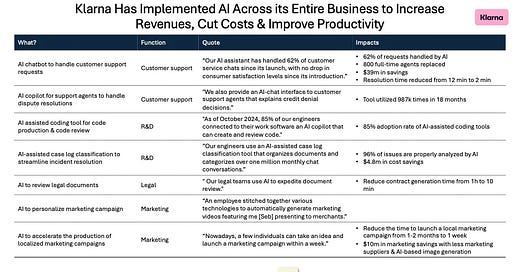Hi, it’s Alex from 20VC. I’m investing in seed & series A European vertical solutions (vSol) which are industry specific solutions aiming to become industry OS and combining dynamics from SaaS, marketplaces and fintechs. Overlooked is a weekly newsletter about venture capital and vSol. Today, I’m digging into Klarna’s story-telling as an AI-powered company which is a great case study of a major player going all-in on Gen. AI.
Klarna recently released its IPO prospectus. The IPO will to be a landmark moment for the European tech ecosystem, with the company aiming to raise over $1bn at a $15bn valuation. Klarna positions itself as “an AI-powered company,” building on two years of aggressive marketing around its leadership in the AI revolution. The company claims to have integrated AI deeply across its operations. In this post, I’ll explore this public case study of a major player going all-in on Gen. AI.
As a caveat, everything Klarna is saying—and what I’m discussing in this post—should be taken with a grain of salt. It’s part of their pre-IPO marketing, and we lack internal insight into what has actually been successfully implemented.
Part 1 - What was the General Process to Ride the Gen. AI Revolution?
After the release of ChatGPT in Nov. 2022, Klarna’s CEO and cofounder, Sebastian Siemiatkowski jumped on a plane to San Francisco to convince Sam Altman and OpenAI to work with Klarna as “Guinea pig” to test and use all their AI products.
Klarna pushed all its employees to start experimenting with Gen. AI. Experiments could unrelated to Klarna’s core business like building a better tool to survey employee engagement. At some point, employees started to come up with projects related to the core business. The first meaningful one was an AI copilot for customer success agents to help them solve dispute which was the genesis of Klarna’s customer success chatbot which has replaced 800 full time agents.
In parallel, Klarna started to structure its company data in a knowledge graph via Neo4j. It was key to make Gen. AI really actionnable. It removed silos between different functions and systems. As a result, Klarna was able to streamline its tech stack and decommission certain enterprise software providers like Salesforce or Workday. On top of this knowledge graph, Klarna implemented Kiki which is both an internal chatbot to query the graph and a Wikipedia-like interface to access company information.
Today, all the functions are using AI in their daily job with a 96% adoption rate of AI tools in the organisation and Klarna has started to push Gen. AI features into its platform like personalised checkout pages to improve conversion rates and an AI shopping assistant.
Part 2 - Where is AI Currently Implemented in the Business?
Klarna has implemented 11 different AI initiatives in its business across different functions: customer support, engineering, legal, marketing, sales and finance.
At the core of Klarna’s AI tech stack is Neo4j which was a pre-requisite to organise data in a way that is exploitable to build internal Gen. AI applications and to plug external Gen. AI providers. Klarna started to transfer, streamline and harmonise its business data into a knowledge graph. The consequence was a consolidation of SaaS products around Klarna’s Neo4j’s knowledge graph and a couple of heavily used SaaS platforms like Slack and Deel.
"A Swedish company, Neo4j introduced us to the beautiful world of graphs. We further explored data modeling, ontology, and, of course, vectors, RAGs, and many things. We store knowledge of Klarna in SaaS, why and what (docs), plans (slides, tickets), performance (sheets), relations (CRM), people (ERP, HR) —all siloed different, creating an unnavigable web of knowledge that requires tons of Klarna specific expertise to operate and utilize. We also recognized that enterprise software has some set of features that are vital for it to operate—features such as audit, versioning, access and edit management, and similar universal needs. Important but further fragmentation that adds friction, admin overhead, and more. We started consolidating; put things together, connect our knowledge, remove the silos. The side consequence of this: liquidation of SaaS—not, but a lot of them. Not for the license fees, though those savings are nice, but for unification and standardisation of knowledge=data. So no, we did not replace SaaS with an LLM, and storing CRM data in an LLM would have its limitations. But we developed an internal tech stack, using Neo4j and other things, to start bringing data=knowledge together.” - Sebastian Siemiatkowski
On top of this, Klarna has built 3 major Gen. AI applications:
An internal knowledge chatbot to help employees to collaborate and find information about Klarna’ business.
A customer service agent to automate 60%+ of customers tickets and to replace the work of 800 full-time agents.
An AI shopping assistant in Klarna’s mobile app to recommend products and special offers to consumers based on their preferences and past behaviours.
Klarna is also using third party Gen. AI providers for other functions like AI copilots for engineers to produce/review code and legal team to produce/review legal contracts.
Part 3 - What are the Outcomes?
Today, Klarna is a much more sustainable company doing much more with less with AI being a key driver in the equation. In 2024, Klarna re-accelerated its growth rate (23.5% YoY growth to generate $2.8bn in revenues vs. 19.5% YoY growth) while becoming profitable and reducing its headcount from 5.5k employees in 2022 to 3.4k today.
Thanks to Julia for the feedback! 🦒 Thanks for reading! See you next week for another issue! 👋





